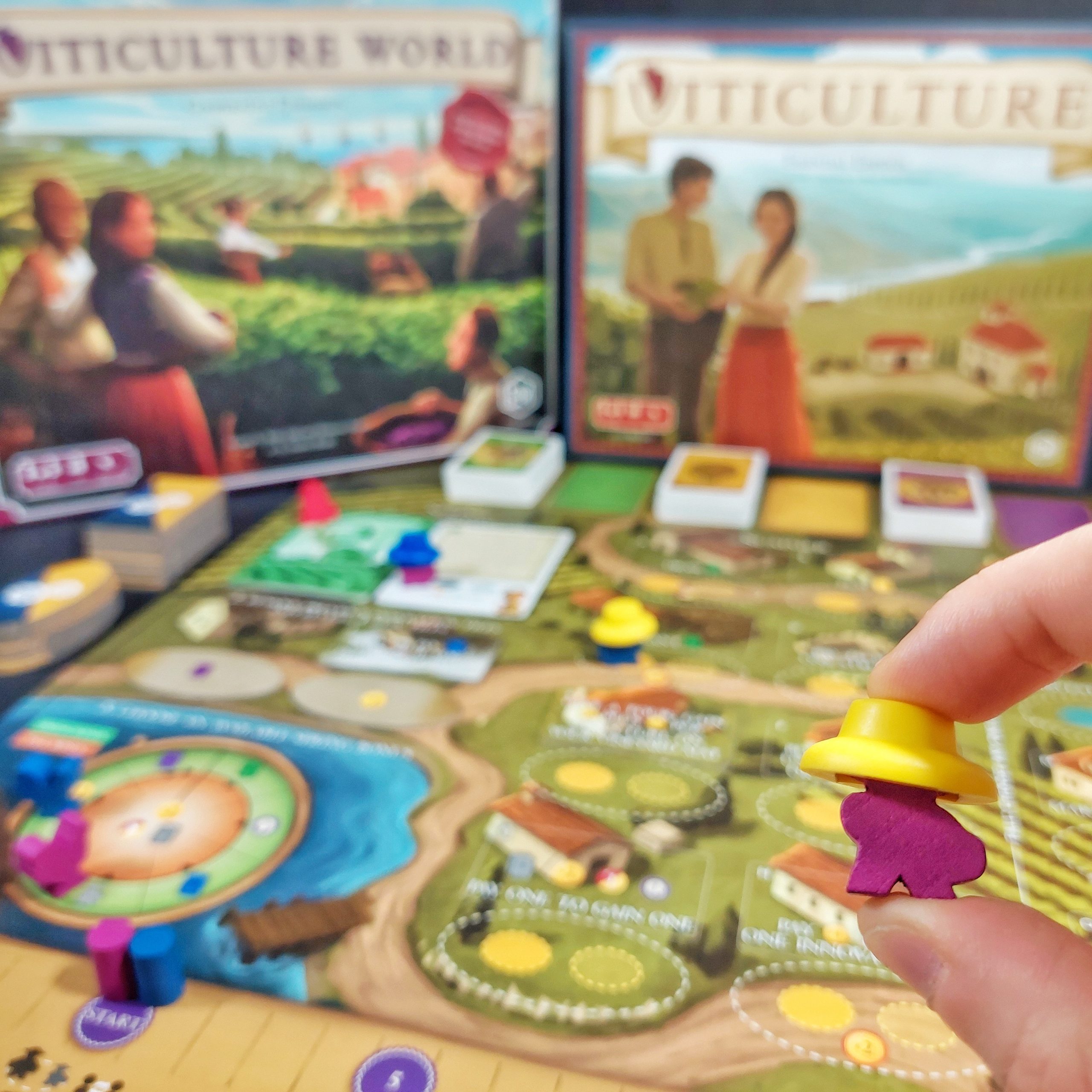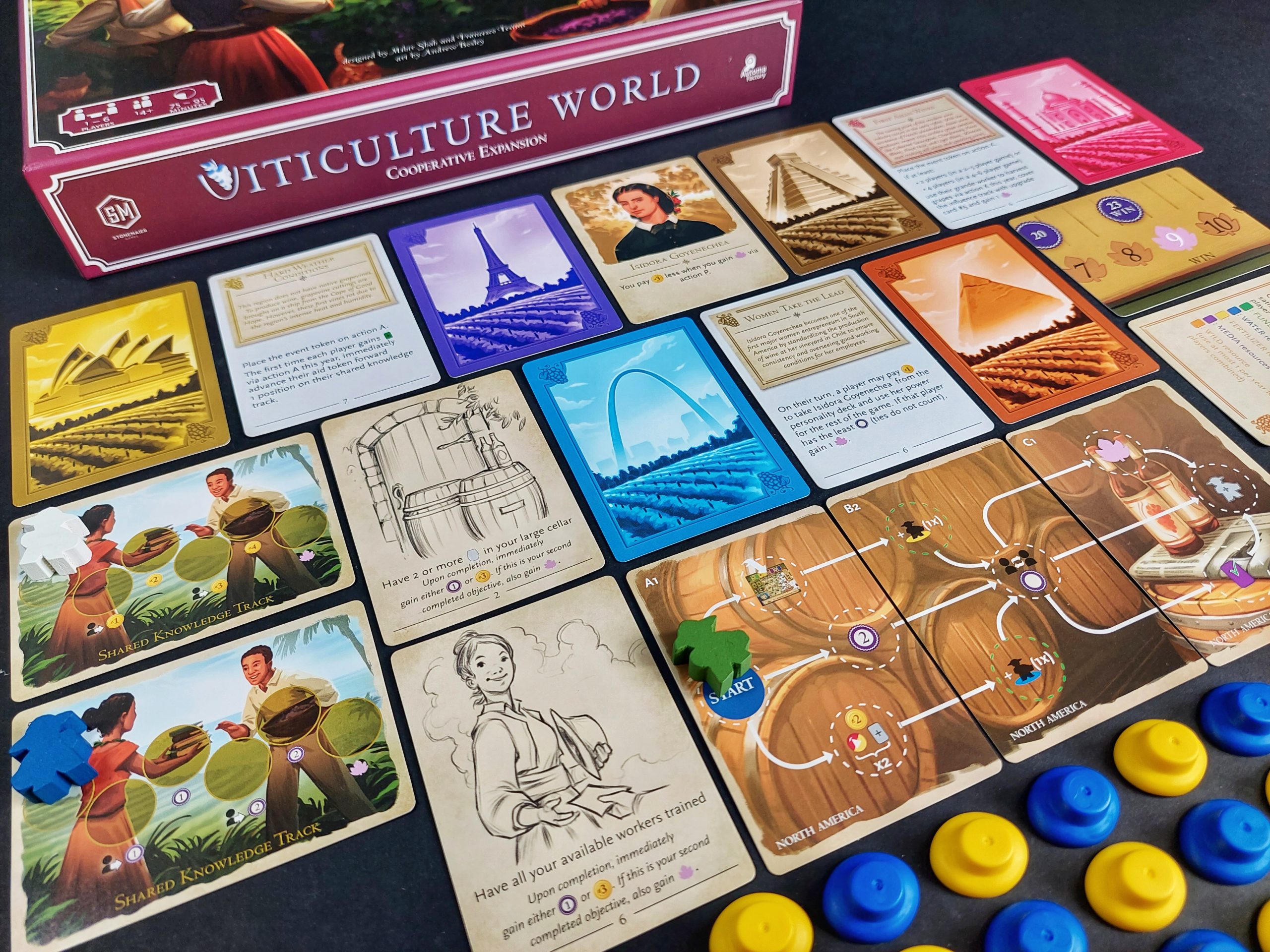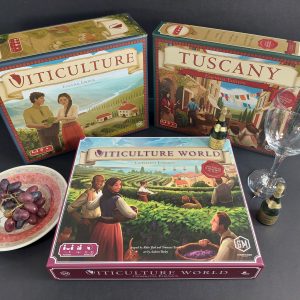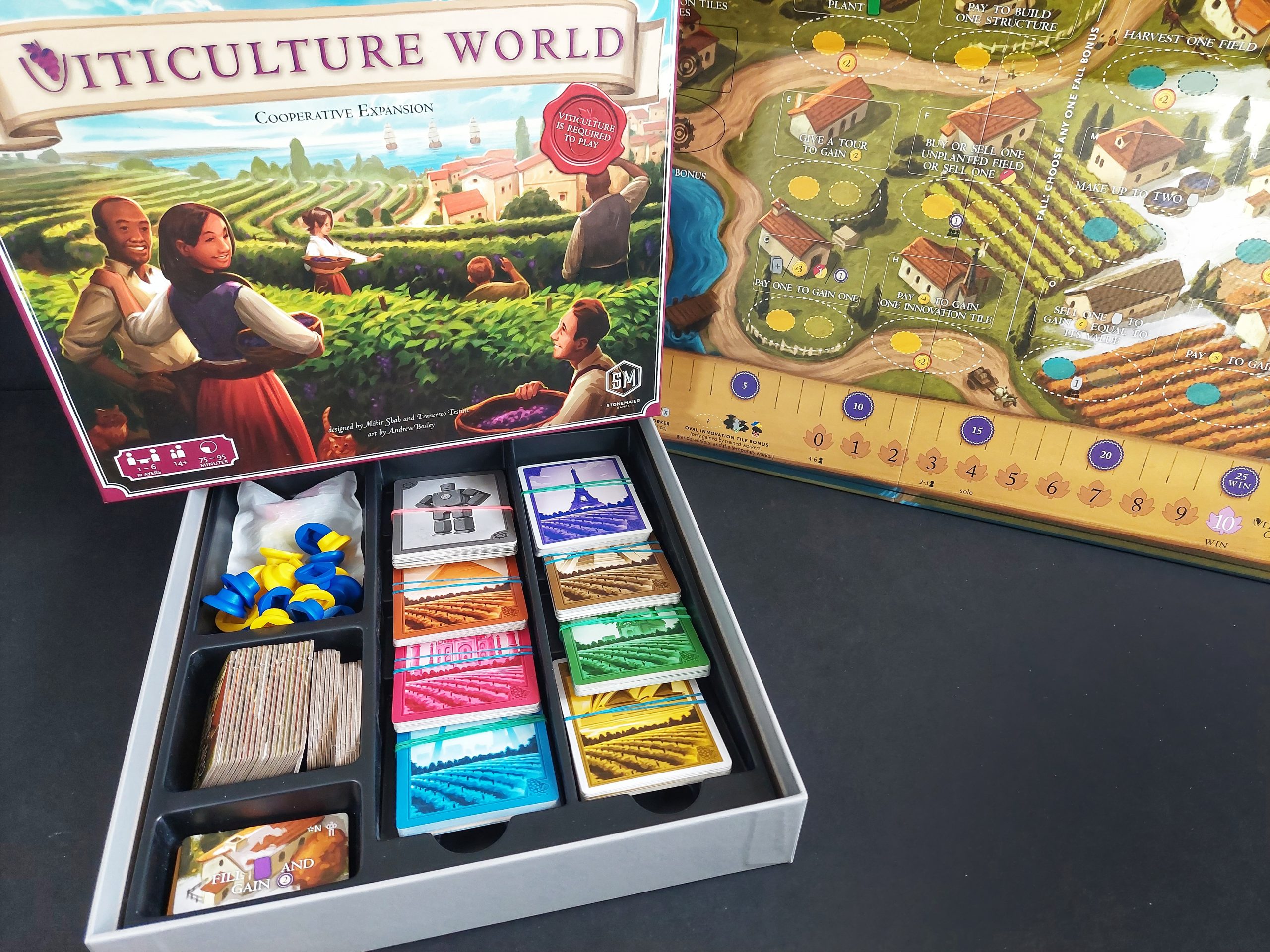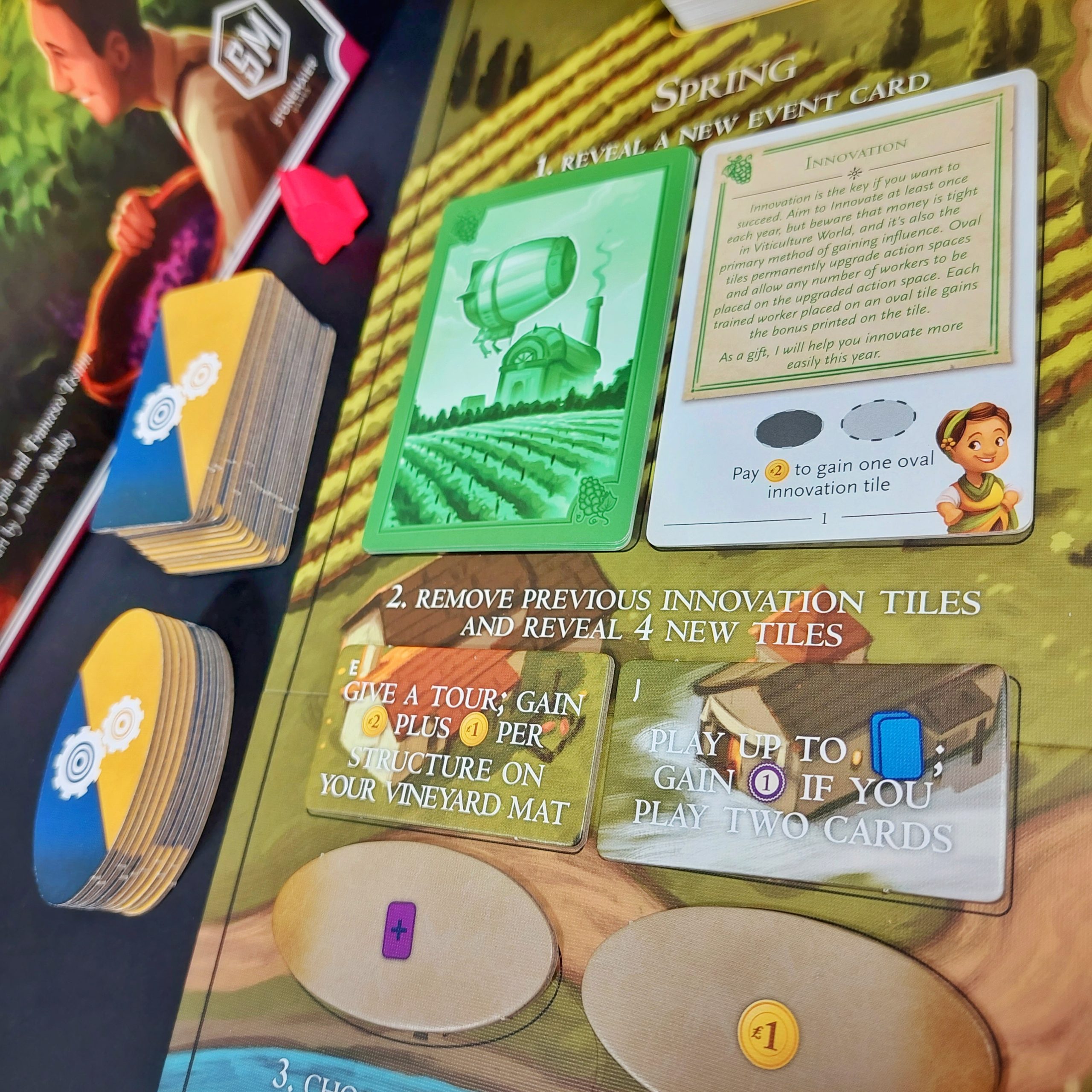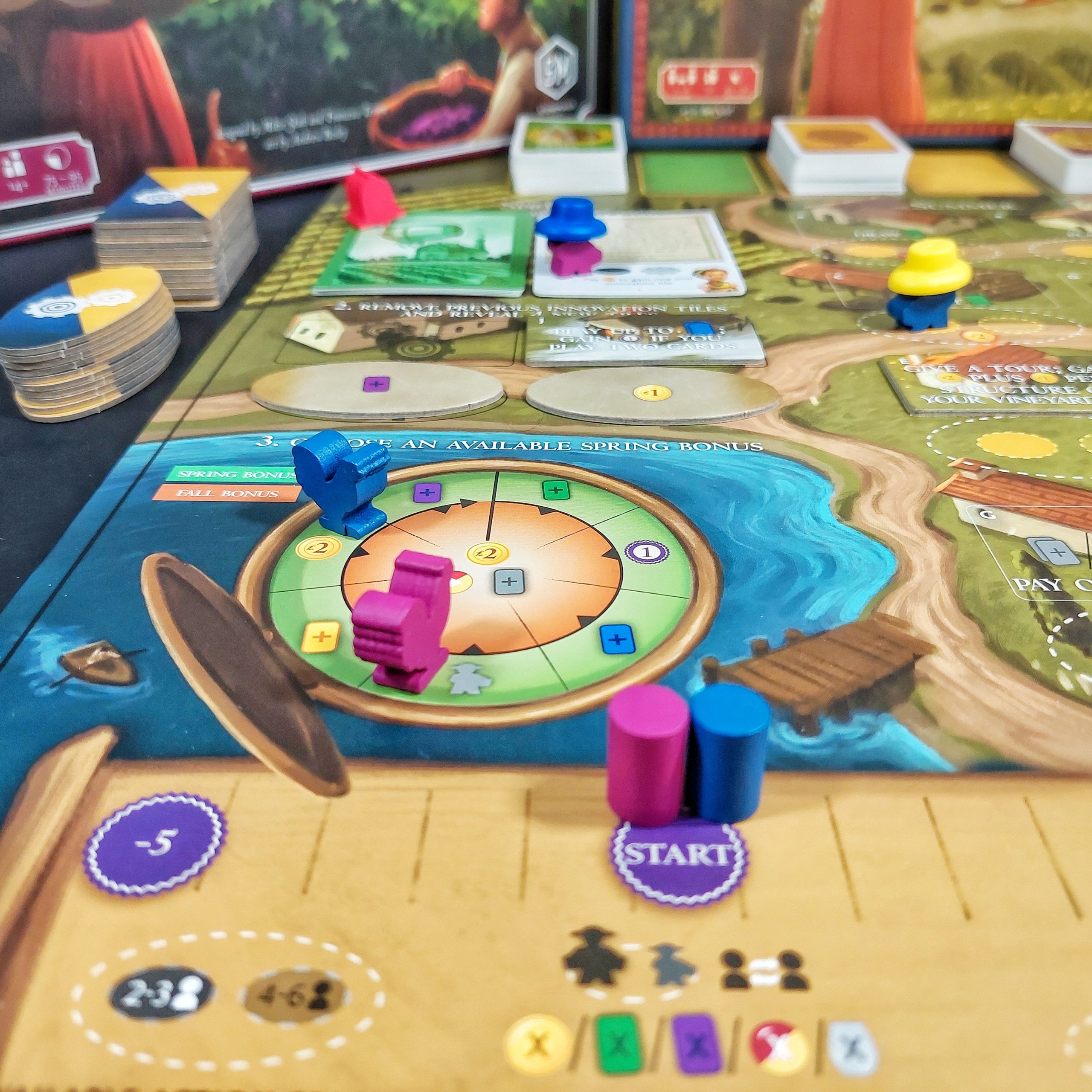Tom is harvesting grapes across the globe in the co-operative expansion, Viticulture World, by Stonemaier Games!
BY TOM HARROD
Publisher: Stonemaier Games
Designer: Mihir Shah and Francesco Testini
Artist: Andrew Bosley
Release date: 2022
Player Count: 1-6 Players
Time: 75-95 minutes
Age: 14+
Score: 9/10
Viticulture has proven tremendous over the years, becoming one of the brightest jewels in Stonemaier Games’ crown. A worker placement game where you run your own vineyard? Sounds like bliss! It’s seen full-on expansions (Tuscany) and additional card decks (Visitors From The Rhine Valley). Tuscany truly is an ‘essential’ expansion, adding in a raft of new options. But it’s nothing on Viticulture World…
Viticulture World is the 2022 addition into the Viticulture family. It is an expansion, meaning you’ll need a copy of Viticulture: Essential Edition to play this. However, given the way that it flips things around, plus the gargantuan variety of new gameplay on offer, it feels like a brand-new standalone experience. The scene is no longer the olive fields of Tuscany. The whole world wants a taste of your vineyard’s grapes!
Slow Down… What’s Viticulture About?
Never played Viticulture before? The aim is to plant vines, and harvest the grapes off them. Convert them into wine, which you store in your cellar. Then, as the years (rounds) progress, your wine (and grapes) mature. You decide when to sell them, to meet wine orders, which are worth points. If you’re smart – and a flexible vineyard owner – you’ll look to liaise with summer and winter guests, to earn points that way, too. It’s a race to see who can score 20VPs first (25VPs, in the Tuscany expansion).
The core concept of Viticulture World twists the gameplay around 180º. This turns Viti into a cooperative worker placement experience. Think of yourselves as various branches within the same vineyard conglomerate, instead of rival businesses. The group’s goal is for every player to hit 25 victory points by the end of six years (rounds). Not only that, you have to ensure that your collective Influence reaches 10/10 before the sixth year ends.
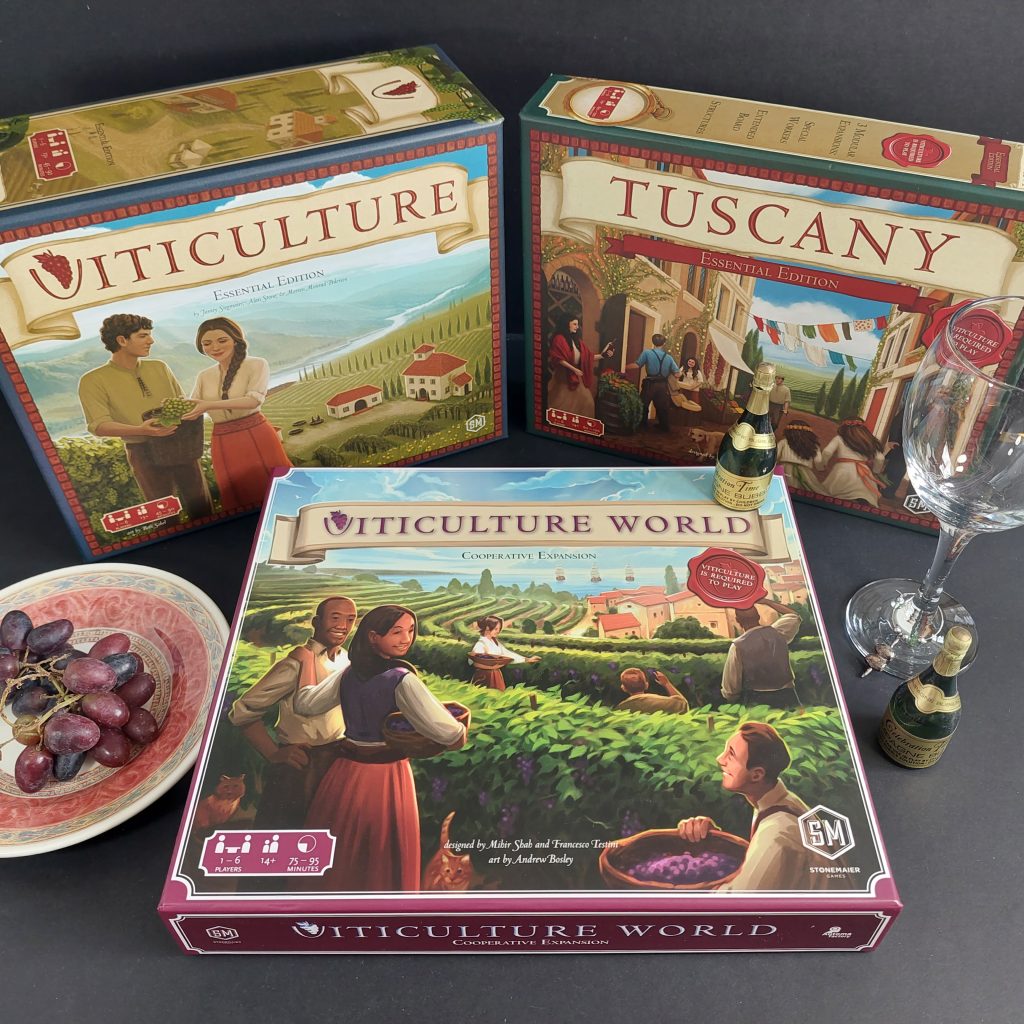
What’s In The Box?
You use Viticulture’s vineyard player boards, the cards, meeples, wine tokens and so on, as per the standard game. But there’s extras aplenty here in World’s box. First up, you get a replacement main board (double-sided, with one providing space for Tuscany’s Structure Cards). You’ll notice the lion’s share of the worker placement locations look familiar. Go here, do this… They’re spread out into summer and winter options. But there’s rectangles and large ovals above and below each of the 16 action spaces. What’s up with that?
That’s because every single action space in Viticulture World can earn an upgrade. You can make it far more efficient and appealing, which in theory make life easier! There’s a whole variety of Innovation Tiles, which overlay the board. You have to spend your hard-earned lira to do this (not to mention an action, itself). But it’s for the greater good: you’re helping everyone else out for the rest of the game! But can you afford the cost?
You’ll also find a baggie full of charming yellow and blue hats. You sit these on your workers, which means they’re either summer (yellow) or winter (blue) workers! You have to spend an action training them to take off that hat, so they can work in either season.
There’s new Mama and Papa Cards, which provide you with asymmetrical starting resources. Last of all, and most impressive of all, there are seven scenarios for you to play (in the form of seven decks of cards). They range in difficulty and tweak and change each game in radical ways. Let’s take a look at all of these fantastic features in greater detail, to see how they drive Viticulture World in a brand new direction…
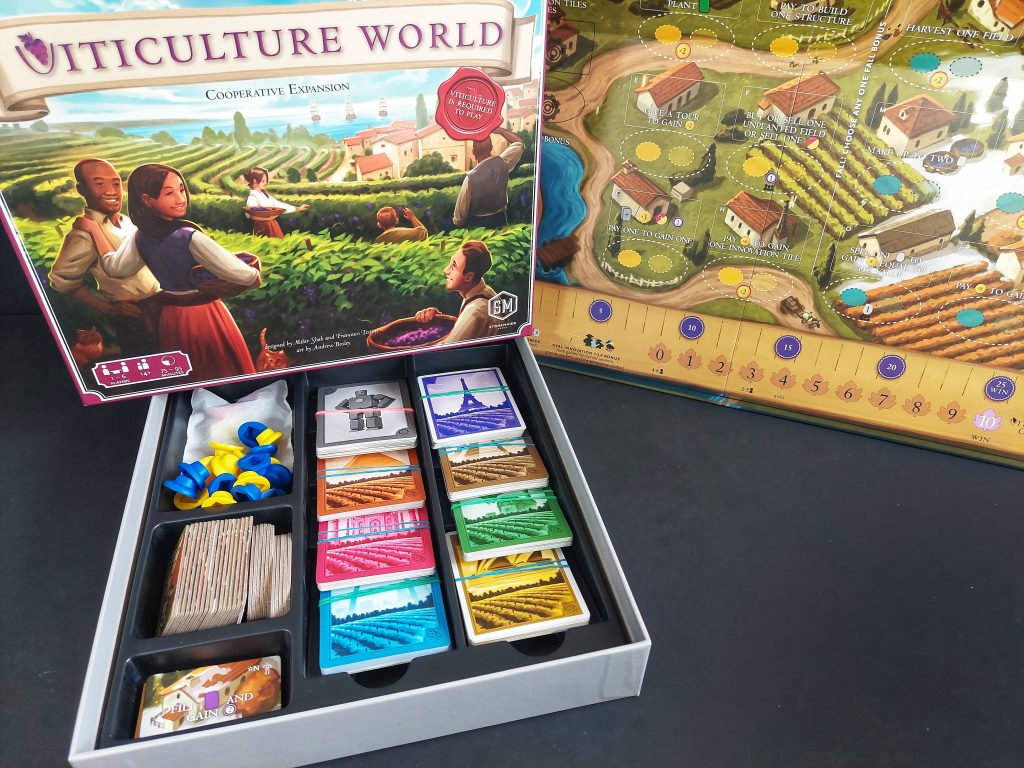
The Upside-Down
Flipping the competitive nature of Viticulture on its head and turning it co-op feels like it started as a “What if…?” conversation. ‘It’s mad… But maybe mad enough to work!’ And boy howdy, does it work. For starters: the bigger picture, the wide-angle master shot. Everything flips. It’s almost as radical a transformation as visiting the The Upside-Down in Stranger Things. It’s Viticulture – but not quite as you know it. Everything’s here, all the familiarities in place… But at the same time, you’re in another plane of existence that feels eerily off-tangent (albeit, in the best possible way).
In a regular worker placement, you might play ‘gotcha’ moves. (Blocking your opponents options in deliberate ways, by snaffling up a spot they want to visit.) But here, you don’t want to do that. The opposite, in fact! Everyone needs to get to that magical 25 point mark. So it’s no good one player hogging all the best options, if they’re blocking everyone else’s progress.
Another amazing thing is the Visitor Cards. They play a huge role in regular Viti. Often, you’ll play one and they offer opponents the chance to do something (like gain a discount, or a free action). But you get a freebie out of it, too. Sometimes you’re loathe to play these, because you don’t want to give goodies to your rivals! But here, the opposite occurs. You want to play them! Because now you’re working together, and it’s in everyone’s interests that you give things to your co-workers. This is an ingenious twist, providing such positive player interaction. (There’s a few Visitor Cards which don’t work in World. Duplicates of them are provided here with a black border, indicating you can ignore them in this co-op mode.)
Like regular Viti, player count-dependent, there’s only so many spaces for workers to visit. At the start of each year, we found ourselves having a post-spring, pre-summer chat about which players wanted to go where! Like with any co-op, there’s a risk of alpha-gaming here (where one player dominates proceedings and delegates). That’s not a fault of the game, but rather, the people with whom you chose to play.
But I’ve missed out an entire season! Spring, don’t worry, I haven’t forgotten you. In fact, one could argue you’re the most radical season of all to hog the ‘new stuff’ limelight…
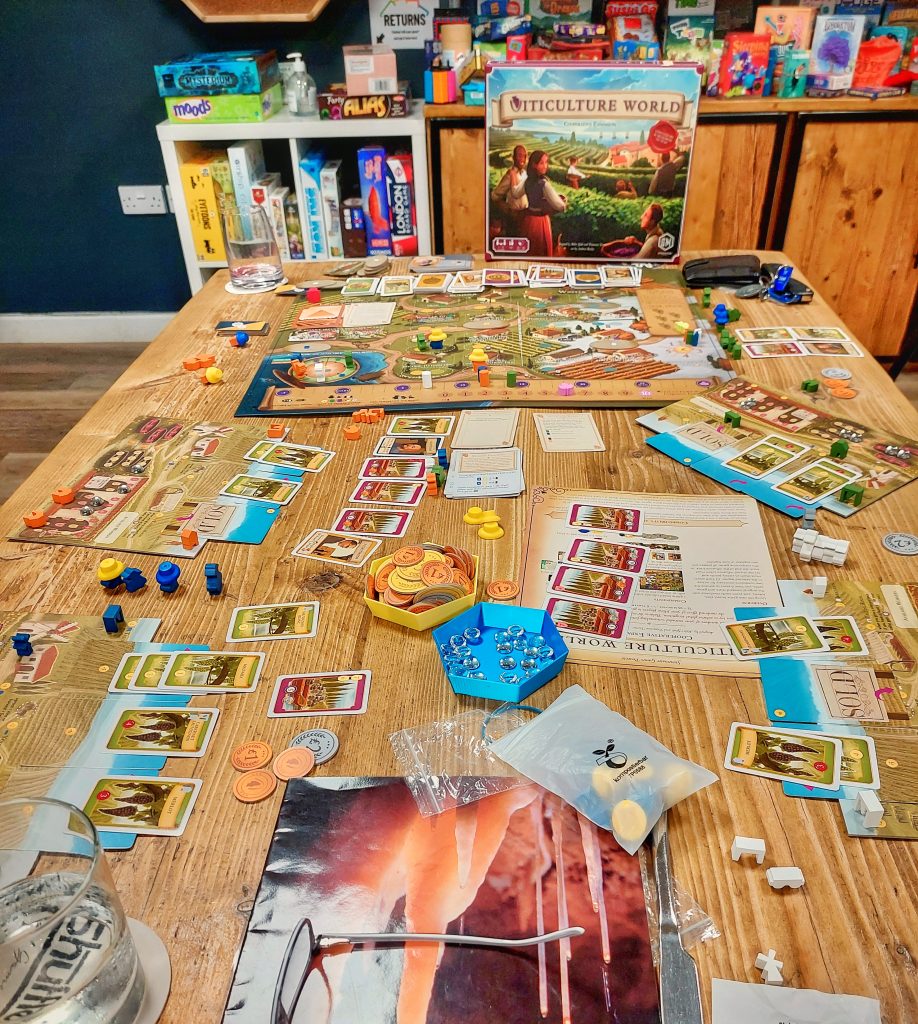
Grape Minds Think Alike
A constant feature throughout Viticulture (and the new board in Tuscany) is the Wake-Up Track. There’s a new one here, decided each spring. Again, as a team, you’ll decide who goes where in turn order, but also which mini-bonus they’ll earn. Whether it’s money, a card, the grey extra worker, a precious victory point… They’re all handy, if a little plain.
This Wake-Up Track isn’t as sophisticated as Tuscany’s. I’ll admit, I prefer the system in that, but I understand why. In competitive Tuscany, the decisions are deeper with regards to turn order. You’re weighing up the pros of going first and getting fewer goodies. Versus, of course, the cons of going last and getting loads of awesome freebies. Turn order feels less important in World – you still need that start-of-year meeting to prevent accidental blocking. But because you’re working together, there’s usually a decent solution. We tended to pick Turn Order positions based on the free stuff we wanted, not necessarily with turn order in mind. There is one counter-argument to this less-flavoursome Wake-Up Track. (It’s to do with your Grande, which I mention in the next section!)
But exciting things occur before your discuss your turn orders for the year. At the start of spring, you reveal the next Continent Card. This is a one-round only rule that applies for this year. I’ll speak more about this later on, but believe me: this is what makes Viticulture World tick. It’s the part that’s going to keep you coming back for more, time and time again.
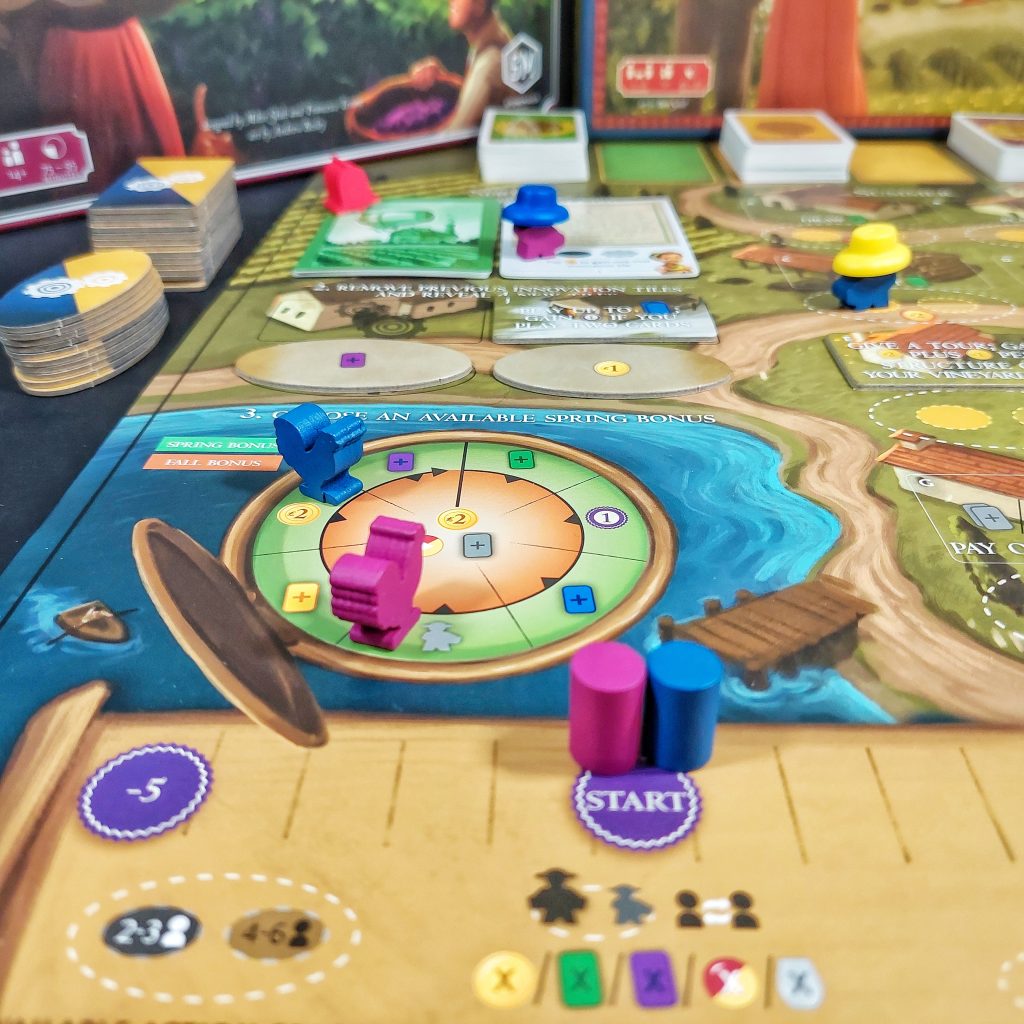
No One Puts Grande In The Corner
Grandes (your bigger meeple worker) were a popular feature of Viticulture. You could always place your Grande on a preoccupied space. Here, Grandes have this ability, and more! First, they don’t start the game wearing a seasonal hat, which means you can play them in either summer or winter. Second, every time you play your Grande, you may participate in a one-for-one trade with another willing player. You can trade any number of coins, Vine/Wine Order Cards, or 1x Grape/Wine Token of any value.
This is a game-changer with regards to helping out a player who’s struggling for a certain resource. During Viticulture World, you may as well play with your hand of cards face-up. It’s in your best interests to tell everyone your intentions, what you have, and how your Guest Cards function. There’s no secrecy here. (Being able to swap items with your teammates feels a fair compromise to the wee-bit-bland Wake-Up Track that I touched on, above.)
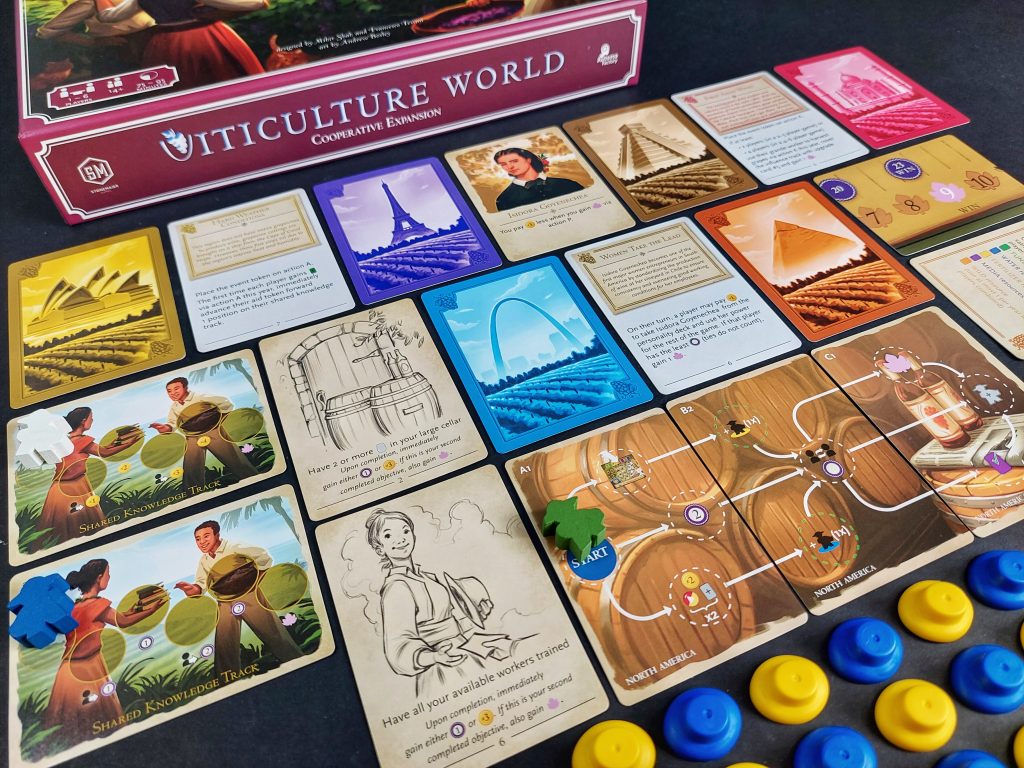
Innovation Tiles: Add A Little ChardoYAY To The Board
One way you can get around stepping on each others’ toes are those Innovation Tiles. There’s a new action space in summer, where you can spend 4 lira to place an Innovation Tile. These are the board improvements; the overlays that increase productivity. At the start of each year, in spring, you reveal four of them (two rectangles and two ovals) into a ‘market’ of sorts.
The rectangles improve the action space itself. They’re lettered A-H to correspond to the summer locations (I-P for winter). The standard return for space A, for example, is come here and ‘gain +1 Vine Card’. The Innovation Tile improvement for this space is ‘draw 3x Vine Cards and choose 2 to keep; then gain 1 grape to your Crush Pad’. That’s a huge upgrade! Especially since many of the grumbles about Viticulture as a game often appear with regards to the luck of the card draw. Yes, in many Euros you make your own luck, but you can live or die by the cards you draw in this game. But with the potential of such powerful Innovation Tiles, flexibility springs from your fingertips!
All 16 of these rectangular Innovations are amazing, in their own ways. Space E improves how much money you gain from giving a wine tour. ‘Gain 2 lira, plus 1 lira per Structure you have on your vineyard mat’. Towards the latter half of the game, I earned 6 or 7 lira from visiting here! And since one of the new spaces in winter is ‘Pay 8 lira to increase the group’s Influence by +1’, money is still vital. (Of course, upgrade this spot and it becomes just ‘pay 6 lira…’ to increase it.)
The wonderful – yet agonising – strategical decisions are which Innovation Tiles to build. You can’t build all of them. Not only do you have to pick between the two rectangular tiles on offer for the year, you also have to consider the oval tiles. These are less rigid; you can place these on any of the 16 locations. The brilliant thing about these is that they cover up the limited quota of spaces for workers to visit. Meaning: once you place an oval Innovation Tile on a location, any number of workers can visit it! We found in the latter years of the game, these were vital. In Years 5 and 6, everybody’s desperate to complete their wine orders to earn last-minute points. With an oval tile in place, you can make this easy as pie. No panic about blocking!
There’s two neat things to consider with regards to the ovals. First, going all George Orwell on you, is that not all spaces are created equally. To overbuild ovals in certain locations you have to pay extra, on top of the standard fee. (It’s often worth it, though.) Thank goodness then, that this mechanism is a fulcrum, and other spaces reward you for placing ovals over them. And in such cases, every player earns the printed reward for overbuilding. Huzzah!
But wait, there’s more. All oval Innovation Tiles have a bonus on them. This could be a free card, a free coin, or an arrow (which mirrors whatever oval Innovation it’s pointing towards). Not only can anyone visit here, but upon doing so you’ll earn said bonus. But there’s a catch. Only trained workers earn this bonus. Grandes are considered trained, but your standard workers aren’t. You can tell because they’re wearing those hats. They start out as mere summer/winter temps. If only there was a way to train them… Oh, wait, of course there is!
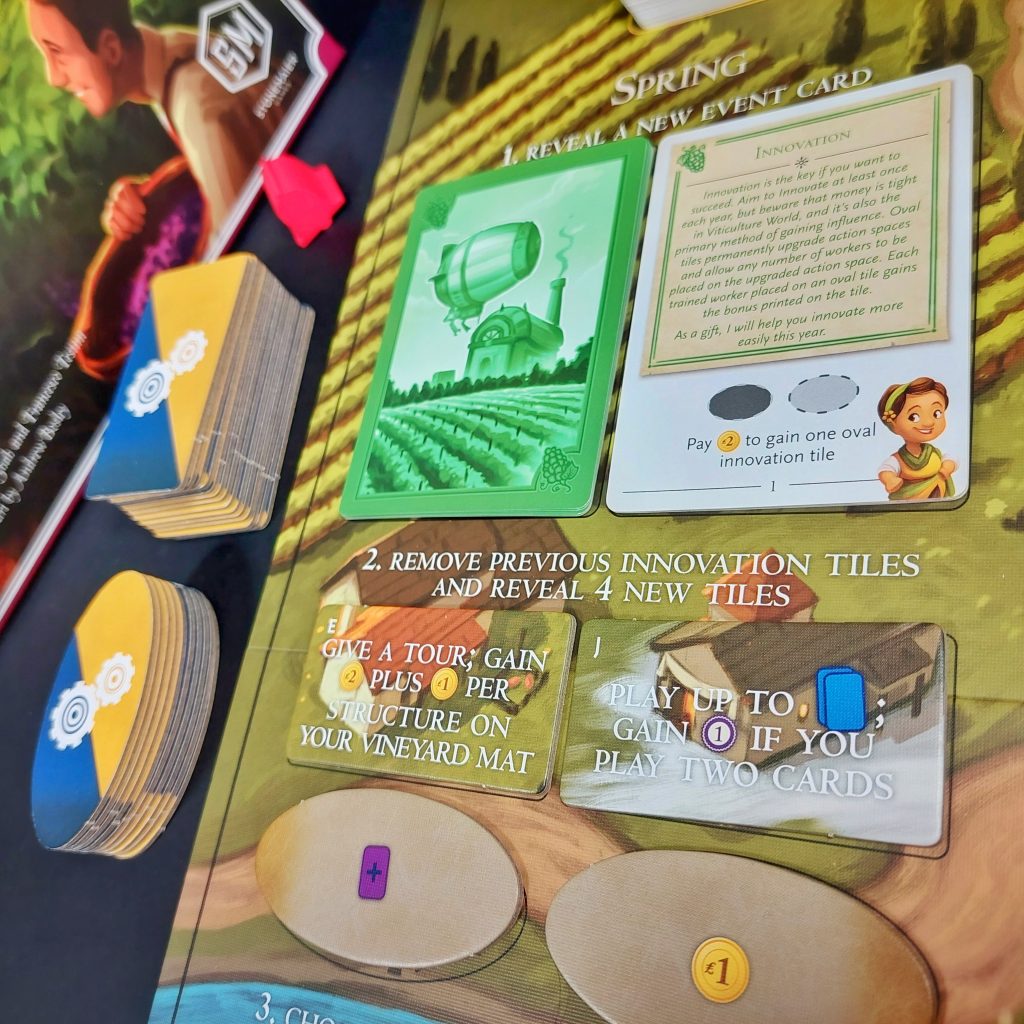
Hats The Way To Do It
In regular Viti, you start with a couple of workers, plus your Grande. You have to work hard (and spend hard) to increase your work force. The rule of thumb tends to be: the more workers you have in any worker placement game, the more stuff you can accomplish. But here, in World, you get to start with four workers plus your Grande straight out of the gate. Oh, so it’s pretty generous, then? Well… Yes, and no.
The Yeses are in the volume. Five workers per year (six if you pick the extra worker on the Wake-Up Track!) means you can hit the ground running. You can accomplish a lot across the year, every year. There’s a strategical snag, though! In regular Viti, it’s a race, but there’s no specific ticking timer. The current leader is the timer. You play as many years as you need, until one player hits 20/25 points. Here it has to be six years or less: no compromises. It’s like designers Mihir Shah and Francesco Testini have said, “Here. Have all the workers you need! But don’t you dare come whining to me with excuses. Get the job done!”
The other aha! moment is that in order for you to race against time, you’re going to need to invest in the Innovation Tiles. There’s no obligation… But I recommend you do. A) They’re fun to see the board change, and B) they make your life so much easier. They are, in the best way possible though, a distraction. It means at least one player (if not two) each year needs to visit location H to buy them. (And probably do an action prior to that to earn the money needed to visit H.) Hence, you need that many workers apiece from the start.
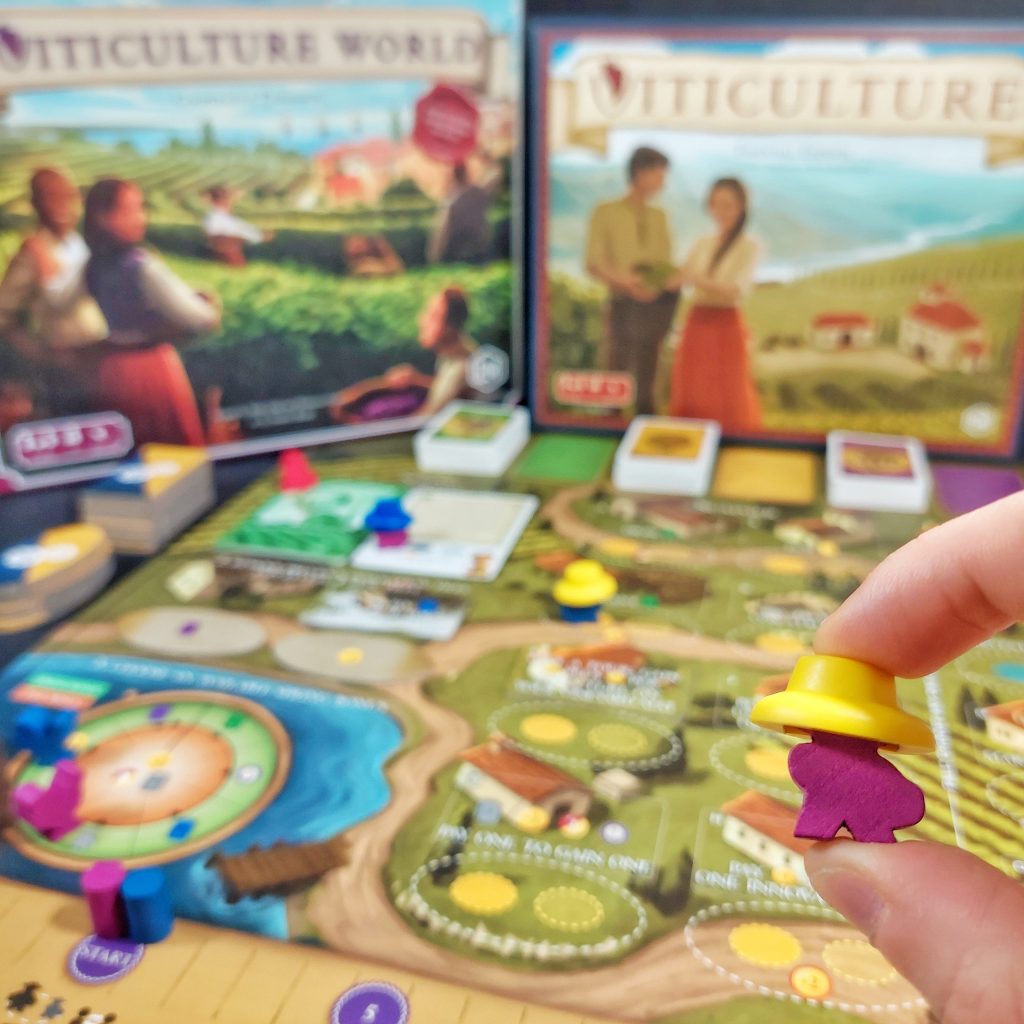
The third tug on the leash is that these four workers start the game with hats. In regular Viti, you have the choice into which season to place your workers. Here, you’re obliged to start the game by playing your two yellow-hat workers in summer, and the blue-hat ones in winter. That isn’t always what you want right now. They haven’t had the right training…
Here, you don’t train them in the regular Viti sense, where you obtain more workers. You train them to remove their hat, and work for you ‘full time’! This means you then have the freedom to place them in either season, for mass flexibility. Plus, when you place trained workers like this onto an oval Innovation Tile, you earn the bonus reward on it. It’s a clever evolution of the location, and how you value your meeple management across the year.
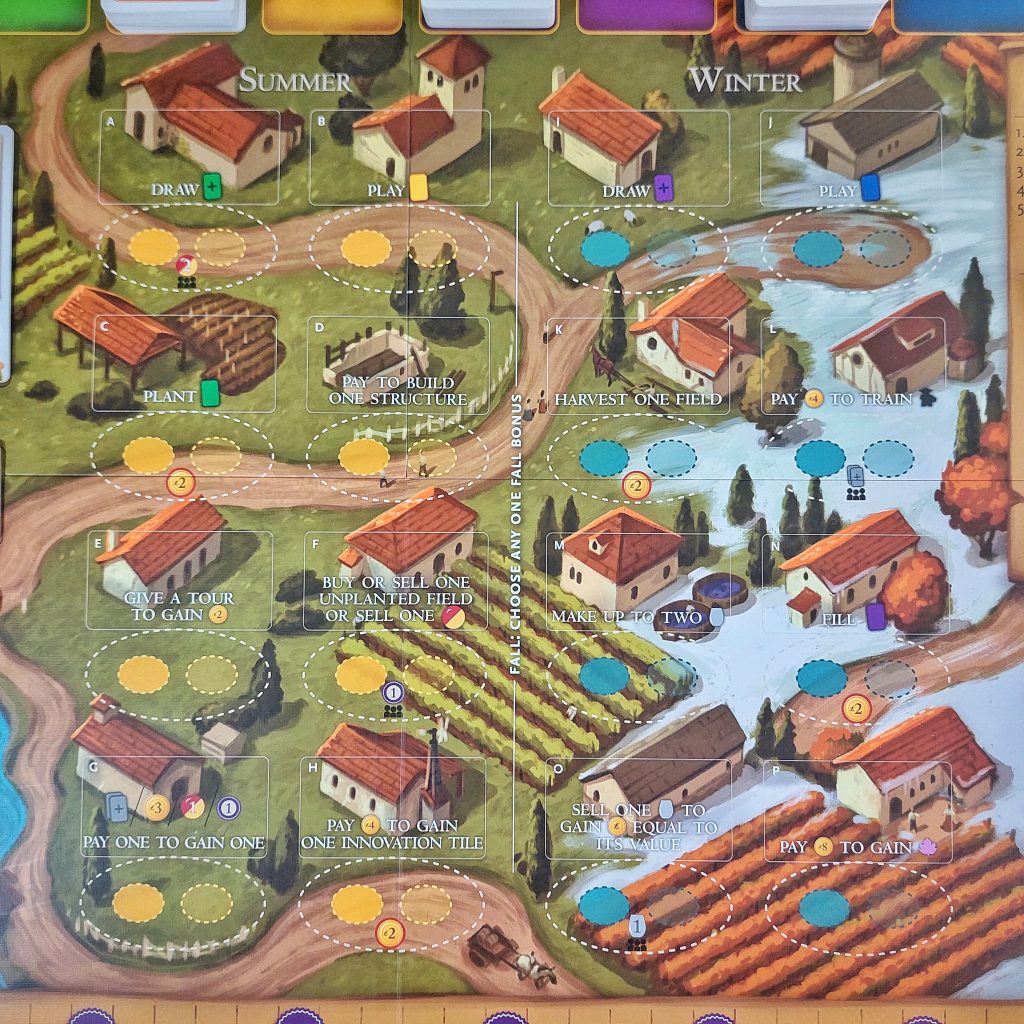
The Continent Of Greengully (Now, Where Have You Heard That, Before?)
And you know what? I haven’t even discussed the most impressive thing of all about Viticulture World yet. The seven Continent Decks are marvellous, and provide you with a plethora of replayability. Seven different ways to play, across seven continents: it is Viticulture World, after all! It’s recommended you start with the Greengully deck, if it’s your first time playing. (The character art on the cards might look familiar here… That’s because they’re the affable folk from Charterstone, another Stonemaier title! A wonderful Easter Egg that will delight SM fans.)
All decks comprise of events, one of which you reveal at the start of each year in spring. Each card has a one-off, unique rule on it for that year, alone. It might be a discount or added points for doing a particular action, or an increased cost. Each deck also has a flavour text introduction to the scenario, as well as a suggested difficulty rating. The decks have an explanation card with regards to specific set-up for that scenario. This tends to involve certain Innovation Tiles, or cards corresponding to that continent’s deck. They’re easy to set up.
The Greengully deck (this ‘continent’ replaces Antarctica, which doesn’t produce wine!) is a hand-holding device. It has six events in it, the cards numbered 1-6. You arrange them in this numerical order, revealing the next number each year. It drip-feeds the rules to you, offering you the card itself as a worker placement location to accomplish an action at a severe discount. It teaches you about the importance of Innovation Tiles, training workers, and so on. It even allows you to have a seventh year, in case you didn’t win in the regular six allocated.
The other years act in a different manner, though. They have more than six events in them, with you shuffling them and revealing only six in a random order. This modular method means you cannot card count or guarantee which event’s coming next.

Asia – Easy
This deck, themed around wine production in Asia, comes with six extra cards that act as overlays on top of the board. Five of them are improvements – one of them is even a lower victory points target for everyone to achieve! You can earn these by completing the event task stated on the card. It’s another potential distraction… But they are worth the extra hoops you have to jump through. Often, one player offers to be the sacrificial lamb so to speak, to accomplish these tasks. There’s eight cards in total in this deck, so there’s no guarantee you’ll get the chance to gain all five improvements.
Europe – Medium
The European deck comes with 12 Objective cards; two get dealt to each player at the start of the game. They’re individual goals for you to achieve. Completing one isn’t that useful (earn 1VP or 3 lira). But if you can complete your second one as well, you get to increase the group’s Influence token by +1, which is vital. These goals are public, so you can help each other achieve these in this regard, during the game.
Oceania – Medium
The Oceania deck requires everyone use their sixth (unused) worker to the player on their left. You deal out one of the six Shared Knowledge Track Cards to each player. They place that other player’s worker on it (on the left-most space). If ever you meet the requirement on the event card for the year, you get to advance the worker on the Shared Knowledge Track. When this worker reaches certain points, either you’ll earn a freebie reward, or your neighbour will. These rewards are all different on each card, ranging from lira, grapes, cards, wine tokens, and points. Reach the end of your track and you get +1 group Influence. It’s nice to help your neighbours!
South America – Medium
In the South America deck of events, a series of historical figures show up, who had a real-life impact on winemaking in the continent. You can spend money to obtain the permanent services of these individuals. In the original printing, two of these characters were conquistadors – Hernán Cortés and Francisco Pizarro. The roles these two men played in history was deeply unpleasant with regards to their treatment towards the indigenous people of South America.
After initial public disapproval and disappointment that such individuals were included, Stonemaier were quick to agree. They created a pack of six replacement cards to omit the conquistadors, which are now going to be included when buying Viticulture World. The journey has a happy ending then, but it’s baffling that something like this slipped through cultural consultancy quality checks. Jamey Stegmaier, to his credit, has held up his hands and taken full responsibility for this. You can read Jamey’s apology blog, here: https://stonemaiergames.com/south-america-cultural-consulting-and-fixing-a-big-mistake/
North America – Medium
North America comes with three cards that make a panoramic ‘Fame Track’. Each player places their sixth, unused meeple at the left-most Start point. If players meet conditions on the event card, they move their meeple one space along the Fame Track. It’s reminiscent of a tech tree, with multiple paths you can opt to take, each stop being an immediate reward. The three cards are double-sided, so you can create eight different Fame Track combinations as part of set-up!
Africa – Hard
The Africa deck is the hardest. The events here all involve players having to throw away cards of specific colours to earn the reward. Not only is throwing certain cards away brutal, sometimes the reward isn’t even that grand! One card, as an example, is ‘throw away as many winter guest cards as there are players’. Each player earns 1 paltry VP! This requires shrewd uses of Grande trading, and Wake-Up Track positions. Building a Cottage (earning Visitor Cards in autumn) is also handy.
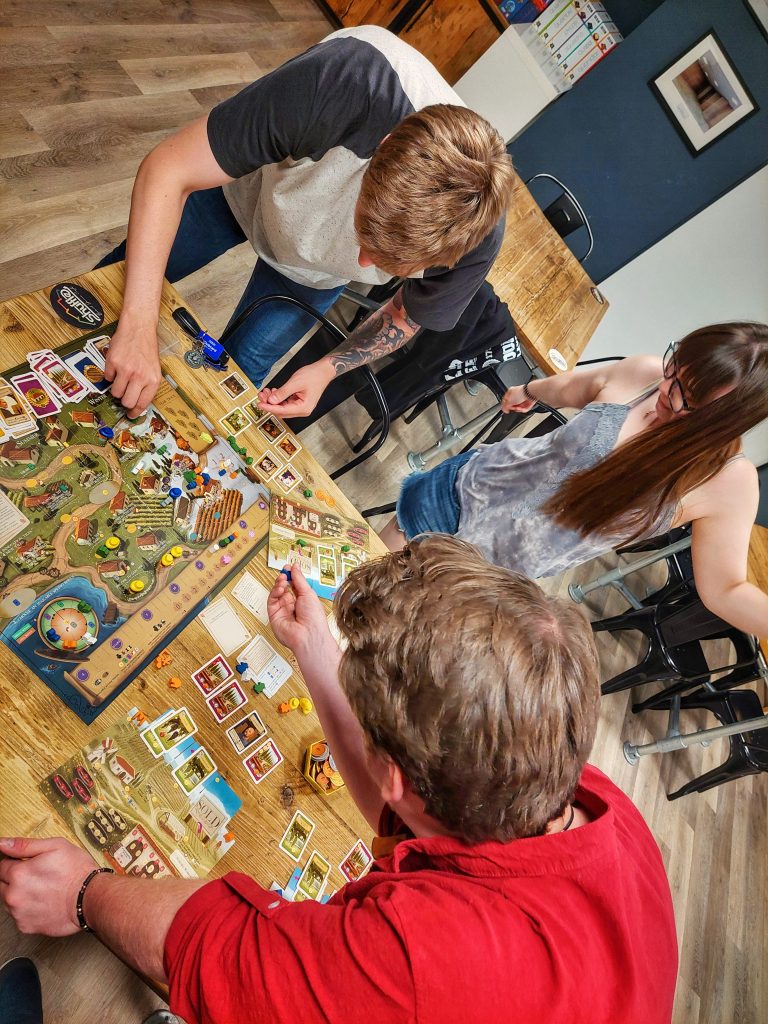
Final Thoughts On… Viticulture World
As you can see, there is an almost-overwhelming range of variety to Viticulture World’s continent decks. Greengully aside (whose deck plays identical each time), the other six are not only unique from one another. Each provides variety within themselves, game-to-game, due to their modular designs. Add into this the way in which the shuffled Innovation Tiles enter the fray. Plus your Mama and Papa. You’ll be pressed to play the exact game of Viticulture World twice!
I adore this facet to Euro-style games, where you have to adapt a new strategy every time you play. Others might not like this approach, so if that’s the case, then perhaps Viticulture World is not for you. But if you feel like you’ve squeezed all the juice out of Viticulture (and even Tuscany), then this is the tonic for you!
As far as co-ops go, it can be a tricky one to win. I playtested my copy with a variety of different players, some of whom had played regular Viticulture, others that hadn’t. They were all ‘gamer-gamers’, though – folks who were used to worker placement games. Them picking it up so quick was in part due to the co-operative nature, where everyone’s trying to help one other.
This might be a step too far for casual gamers in terms of complexity, though. In that regard, I’d suggest folks play regular Viti first, to get a taster. Then you’ll be able to sidestep into Viticulture World, with some vineyard experience under your belt. The iconography is constant throughout both titles, despite World being inked by Andrew ‘Everdell’ Bosley this time around. Bosley’s charming art enters the scene via the Continent Decks.
Greengully is a perfect introductory scenario, though. It drops obvious hints with the event cards, helping you learn the game. You’re unlikely to want to play Greengully again – afterwards, you’ll want the challenge of the six other decks. Each one also works from a solo gaming point of view, too. You play with a virtual partner, with an element of irony involved. Their automa deck sees them block certain worker placement spots each season! But they do generate regular automatic income, which you can spend on their behalf to help you out. On the whole though, the blocking nature makes this solo mode feel more competitive than co-op.
On the other end of the scale, I think six players is too many for this. That’s a common trait with many co-ops – it’s a case of too many cooks. Not only will the game take longer due to extra players, but the decisions you need to make to avoid blocking means more stodge. For me, similar to regular Viti, four players is the sweet spot. The player scaling differs for a smaller player counts, with the group Influence having a head-start on its track. We thought we’d lost our first game of it (at two players), with a daunting quantity of points still needed in year six. But your vineyard engine will rumble into efficiency by this point, and your points start to accelerate.
Six years can feel tough to achieve everything, but it’s an ideal length to provide a real race against time. When you win, it’s likely to be by the skin of your teeth, which the best way to win, right? You want games that act like a rollercoaster, fluctuating between buttock-clenching panic and raucous cheering.
When Tuscany: Essential Edition came along, it was a genuine essential add-on for the base game. While it might not include the ‘EE’, Viticulture World is another expansion no Viticulture fan can ignore. It gets better with every sip. This one is going to rock your world!



